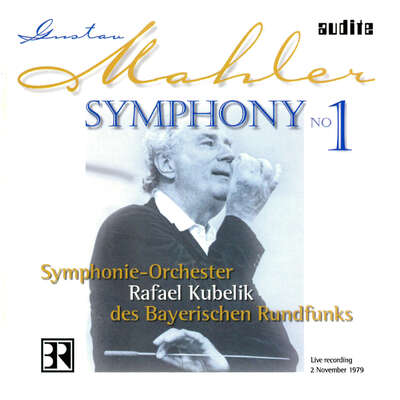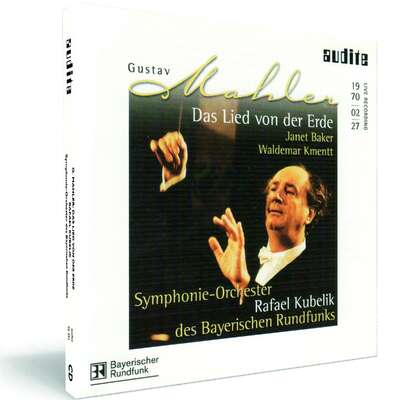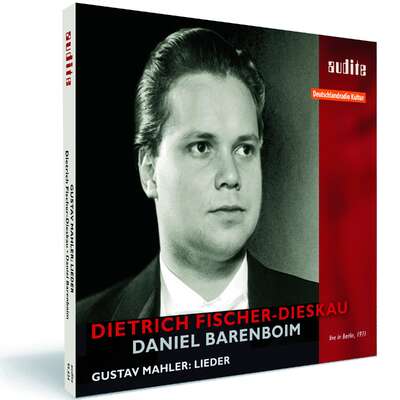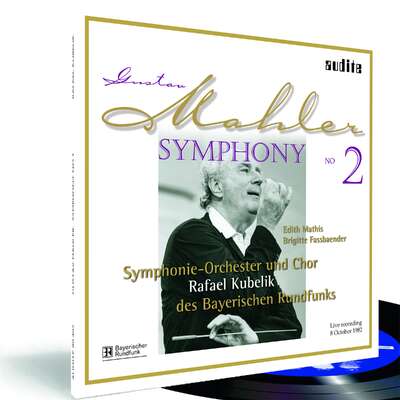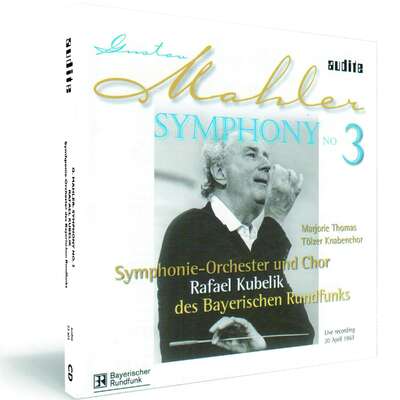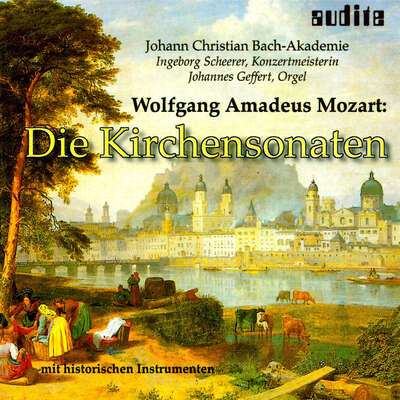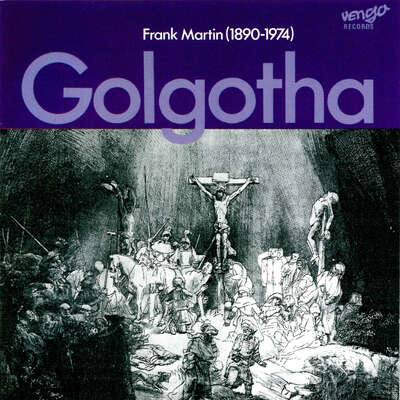
Mahler already broke through the previously valid dimensions and conventions in his first symphonic work written in 1888. No one had ever dared to express such an extreme alteration of feelings between apparently naive Romanticism and utter despair in music before. The passages of idyllic...more
"...you won't find readings of greater warmth, humanity and patient sensitivity. That the pulse has slowed just a little is all to the good, and the more spacious sonic stage preserved by Bavarian Radio bathes the music-making in an appealing glow without serious loss of details." (Gramophone)
Details
| Gustav Mahler: Symphony No. 1 | |
| article number: | 95.467 |
|---|---|
| EAN barcode: | 4009410954671 |
| price group: | BCB |
| release date: | 1. January 2000 |
| total time: | 51 min. |
Informationen
Mahler already broke through the previously valid dimensions and conventions in his first symphonic work written in 1888. No one had ever dared to express such an extreme alteration of feelings between apparently naive Romanticism and utter despair in music before. The passages of idyllic transfiguration are repeatedly swept away by sudden demonic outbursts; the Finale, designated as "triumphal" by Mahler himself, cannot erase the memory of the preceding abysses and does not have the effect of a definitive resolution towards positive affirmation of life. Rafael Kubelik and the Bavarian Radio Symphony succeed in allowing the listener to experience the poetic as well as the dramatic passages with equal intensity and with a fascinating musical sense of suspense. The work appears in a live recording from the Herkulessaal of the Munich Residenz made on 2 November 1979.
Reviews
Sunday Times | 5 December 2010 | David Cairns | December 5, 2010
Sunday Times classical records of the year<br /> <br /> Kubelik inspires his BavarianMehr lesen
Kubelik inspires his Bavarian
Sunday Times | May 30, 2010 | Dan Cairns | May 30, 2010
The Czech conductor Rafael Kubelik’s years as director of the BavarianMehr lesen
Classica-Répertoire | novembre 2006 | Stéphane Friédérich | November 1, 2006
ecoute comparée – La Symphonie n°1 «Titan» de Gustav Mahler
Audition en aveugle
Rafael Kubelik et l'Orchestre symphonique de la Radio de Bavière (DG,Mehr lesen
www.musicweb-international.com | 1/2004 | Tony Duggan | January 1, 2004
For many Mahlerites over a certain age Rafael Kubelik has always been there, like a dependable uncle, part of the Mahler family landscape for as longMehr lesen
Yet it has never quite made the "splash" those by some of his colleagues have done. Kubelik’s view of Mahler is not one that attaches itself to the mind at a first, or even a second, listening. Kubelik was never the man for quick fixes or cheap thrills in any music he conducted. So in Mahler not for him the heart-on-sleeve of a Bernstein, the machine-like precision of a Solti, or the dark 19th century psychology of a Tennstedt. Kubelik’s Mahler goes back to folk roots, pursues more refined textures, accentuates song, winkles out a lyrical aspect and so has the reputation of playing down the angst, the passion, the grandeur. But note that I was careful to use the word "reputation". I often wonder whether those who tend to pass over Kubelik’s Mahler as honourable failure have actually listened hard over a period of time to those recordings. I think if they had they would, in the end, come to agree that whilst Kubelik is certainly excellent at those qualities for which his Mahler is always recognised he is also just as capable of delivering the full "Mahler Monty" as everyone else is. It’s just that he anchors it harder in those very aspects he is praised for, giving the rest a unique canvas on which he can let whole of the music breathe and expand. It’s all a question of perspective. Kubelik’s Mahler takes time, always remember that.
In his studio cycle the First Symphony has always been one of the most enduring. It has appeared over and over again among the top recommendations of many critics, including this one. Many others who tend not to rate Kubelik highly in certain later Mahler Symphonies if they were of a mind to rate his First Symphony might feel constrained to point out that the First is, after all, a "Wunderhorn" symphony and that it is in the "Wunderhorn" mood Kubelik was at his strongest. I don’t disagree with that as an explanation but, as I have said, I think that in Mahler Rafael Kubelik was so much more than a two or three trick pony. In fact in the First Symphony Kubelik’s ability to bring out the grotesques, the heaven stormings and the romance was just as strong as Bernstein or Solti. It’s a case of perspectives again.
The studio First Symphony did have one particular drawback noted by even its most fervent admirers. A drawback it shared with most of the other recordings in the cycle too. It lay in the recorded sound given to the Bavarian Radio Orchestra by the DG engineers in Munich. Balances were close, almost brittle. The brass, trumpets especially, were shrill and raucous. There was an overall "boxy" feeling to the sound picture. I have never been one to dismiss a recording on the basis of recorded sound alone unless literally un-listenable. However, even I regretted the sound that this superb performance had been given. This is not the only reason I am going to recommend this 1979 "live" recording on Audite of the First over the older DG, but it is an important one. At last we can now hear Kubelik’s magnificent interpretation of this symphony, and the response of his excellent orchestra, in beautifully balanced and realistic sound about which I can have no criticism and nothing but praise.
Twelve years after the studio recording Kubelik seems to have taken his interpretation of the work a stage further. Whether it’s a case of "live" performance before an audience leading him to take a few more risks, play a little more to the gallery, or whether it’s simply the fact that he has thought more and more about the work in subsequent performances, I don’t know. What I do know is that every aspect of his interpretation I admired first time around is presented with a degree more certainty, as though the 1967 version was "work in progress" and this is the final statement. (Which, in fact, it was when you consider Kubelik first recorded the work for Decca in Vienna in the 1950s.)
Straight away the opening benefits from the spacious recording with the mellow horns and distant trumpets really giving that sense of otherworldliness that Mahler was surely aiming for. Notice also the woodwinds’ better balancing in the exposition main theme which Kubelik unfolds with a telling degree more lyricism. One interesting point to emerge is that after twelve years Kubelik has decided to dispense with the exposition repeat and it doesn’t appear to be needed. In the development the string slides are done to perfection, as good as Horenstein’s in his old Vox recording. Kubelik also manages an admirable sense of mounting malevolence when the bass drum starts to tap softly. Nature is frightening, Mahler is telling us, and Kubelik agrees. The recapitulation builds inexorably and the coda arrives with great sweep and power. At the end the feeling is that Kubelik has imagined the whole movement in one breath.
The second movement has a well-nigh perfect balance of forward momentum and weight. There is trenchancy here, but there is also a dance element that is so essential to make the music work. Some conductors seem to regard the Trio as a perfunctory interlude, but not Kubelik. He lavishes the same care on this that he lavishes on everything else and the pressing forward he was careful to observe in the main scherzo means he doesn’t need to relax too much in order to give the right sense of respite. There is also an air of the ironic, a feeling we are being given the other side of one coin.
The third movement is one of the most extraordinary pieces of music Mahler ever wrote. The fact that it was amongst his earliest compositions makes it even more astounding. I have always believed that in this movement Mahler announces himself a a truly unique voice for the first time and Kubelik certainly seems to think this in the way he rises to the occasion. He has always appreciated the wonderful colours and sounds that must have so shocked the first audience but in this recording we are, once more, a stage further on in the interpretation than in his previous version. Right at the start he has a double bass soloist prepared to sound truly sinister, more so than in 1971, and one who you can really hear properly also. As the funeral march develops a real sense of middle European horror is laid out before us. All the more sinister for being understated by Mahler but delivered perfectly by a conductor who is prepared to ask his players to sound cheap, to colour the darker tones. This aspect is especially evident in the band interruptions where the bass drum and cymbals have a slightly off-colour Teutonic edge which, when they return after the limpid central section, are even more insinuating and menacing. Kubelik seems to have such confidence in the music that he is able to bring off an effect like this where others don’t. In all it’s a remarkably potent mix that Kubelik and his players deliver in this movement though he never overplays, always anchors in the music’s roots.
In the chaos unleashed at the start of the last movement you can now, once more, hear everything in proper perspective, the brass especially. The ensuing big tune is delivered with all the experience Kubelik has accumulated by this time, but even I caught my breath at how he holds back a little at the restatement. Even though the lovely passage of nostalgic recall just prior to the towering coda expresses a depth and profundity only hinted at in 1967 it is the coda itself which will stay in your mind. As with the studio recording Kubelik is anxious for you to hear what the strings are doing whilst the main power is carried by brass and percussion. Kubelik is also too experienced a Mahlerian to rush the ending. Too many conductors press down on the accelerator here, as if this will make the music more exciting, and how wrong they are to try. Listen to how Kubelik holds on to the tempo just enough to allow every note to tell. He knows this is so much more than just a virtuoso display, that it is a statement of Mahler’s own arrival, and his care and regard for this work from start to finish stays with him to the final note.
This is a top recommendation for this symphony. It supersedes Kubelik’s own studio recording on DG and, I think, surpasses in achievement those by Horenstein (Vox CDX2 5508) and Barbirolli (Dutton CDSJB 1015) to name two other favourite versions I regard as essential to any collection but which must now be thought of as alternatives to this Audite release.
Simply indispensable.
Zeitpunkt Studentenführer | 1/2004 | Beate Hiltner-Hennenberg | January 1, 2004
„Wie mit einem Schlag sind alle Schleusen in mir geöffnet!“ –Mehr lesen
El País
| 19.04.2003 | Javier Pérez Senz | April 19, 2003
Kubelik, en el corazón de Mahler
Dos sinfonías de Gustav Mahler grabadas en vivo abren la edición que el sello Audite dedica al director checo Rafael Kubelik, uno de los grandes mahlerianos de la historia.
[...] dirige el célebre adagietto con un encendido lirismo y una intensidad que hipnotiza al oyente –, situándose entre las mejores de la discografía.Mehr lesen
Classic Record Collector | 10/2002 | Christopher Breunig | October 1, 2002
The German firm Audite has given us not only this near complete live cycle of Mahler symphonies (sans 4 or 8), but valuable Kubelik/Curzon readings ofMehr lesen
Recorded between 1967 and 1971, Kubelik’s DG cycle has been at budget price for some time now and the Audite alternatives of 1, 5 and 7 have been in the shops for months. The NHK-recorded Ninth, made during a 1975 Tokyo visit by the Bavarian RSO, was reviewed in CRC, Spring 2001 (I found the sound unfocused and the brass pinched in sound, but welcomed in particular playing ‘ablaze’ after the visionary episode in the Rondo burleske and a crowning final). No. 1 in DG is widely admired but this 1979 version is more poetic still, wonderfully so in the introduction and trio at (II). There is something of a pall of resonance in place of applause, cut from all these Audite transfers. In No. 7 the balance is more airy than DG’s multi-miked productions, and (as in No. 5) Kubelik sounds less constrained than when working under studio conditions, although rhythm in the opening bars of (II) goes awry and the very opening note is succeeded by a sneeze! The disturbing and more shadowy extremes are more vividly characterized, the finale a riotous display.
Some critics feel that Kubelik gives us ‘Mahler-lite’, which may seem in comparison with, say, Chailly’s Decca cycle or the recent BPO/Abbado Third on DG – not to mention Bernstein’s. But there is plenty of energy here, and the divided strings with basses set to the rear left give openness to textures. However, the strings are not opulent and the trumpets are often piercing. It would be fair to say that Kubelik conducted Mahler as if it were Mozart!
As it happens, in the most controversial of his readings, No. 6, the DG is preferable to the Audite, where Kubelik projects little empathy with its slow movement and where the Scherzo is less cohesive. The real problem is that the very fast speed for (I) affects ail subsequent tempo relationships. Nor does the finale on No. 3, one of the glories of the DG cycle, quite have the same radiance; the singers are the same, the Tölz Boys making a sound one imagines Mahler must have heard in his head, and this performance predates the DG by one month. Nevertheless, these newer issues of Nos 2 and 3 are worth hearing, the ‘Resurrection’ not least for Brigitte Fassbaender’s account of ‘Urlicht’.
Nowadays every orchestra visiting London seems to programme Mahler’s Fifth Symphony as a showpiece, but in 1951 (when Bruno Walter’s 78rpm set was the collector’s only choice) a performance would surely have been uncommon even at the Concertgebouw – Mengelberg was prohibited from conducting in Holland from 1946 until he died that year. Although the start of (V) is marred by horns, this is an interesting, well executed account with a weightier sound, from what one can surmise through the inevitable dimness – the last note of (I) is almost inaudible. The three versions vary sufficiently to quote true timings (none is given by Tahra): (I) 11m 34s/12m 39s/11m 35s (Tahra/Audite/DG); (II) 13m/14m 52s/13m 52s; (III) 15m 56s/17m 54s/17m 23s; (IV) 9m 24s/10m 24s/9mm 44s); (V) 14m 26s/14m 57s/15m 29s. The live Munich version is tidier than on DG; the spectral imagery in (III) is heavier in effect, too; and in the Adagietto the dynamic and phrasing shadings and poetic quality of the string playing also give the live performance the edge. Towards the end of the finale, and elsewhere, the engineers reduced dynamic levels.
Tahra’s booklet comprises an untidily set-out synopsis of Kubelik’s career. Audite’s have full descriptions of the works with text for Nos 2 and 3, and different back-cover colour portraits of the conductor.
International Record Review | 10/2002 | Christopher Breuning | October 1, 2002
The German firm Audite has given us not only this near complete live cycle of Mahler symphonies (sans 4 or 8), but valuable Kubelik/Curzon readings ofMehr lesen
Recorded between 1967 and 1971, Kubelik’s DG cycle has been at budget price for some time now and the Audite alternatives of 1, 5 and 7 have been in the shops for months. The NHK-recorded Ninth, made during a 1975 Tokyo visit by the Bavarian RSO, was reviewed in CRC, Spring 2001 (I found the sound unfocused and the brass pinched in sound, but welcomed in particular playing ‘ablaze’ after the visionary episode in the Rondo burleske and a crowning final). No. 1 in DG is widely admired but this 1979 version is more poetic still, wonderfully so in the introduction and trio at (II). There is something of a pall of resonance in place of applause, cut from all these Audite transfers. In No. 7 the balance is more airy than DG’s multi-miked productions, and (as in No. 5) Kubelik sounds less constrained than when working under studio conditions, although rhythm in the opening bars of (II) goes awry and the very opening note is succeeded by a sneeze! The disturbing and more shadowy extremes are more vividly characterized, the finale a riotous display.
Some critics feel that Kubelik gives us ‘Mahler-lite’, which may seem in comparison with, say, Chailly’s Decca cycle or the recent BPO/Abbado Third on DG – not to mention Bernstein’s. But there is plenty of energy here, and the divided strings with basses set to the rear left give openness to textures. However, the strings are not opulent and the trumpets are often piercing. It would be fair to say that Kubelik conducted Mahler as if it were Mozart!
As it happens, in the most controversial of his readings, No. 6, the DG is preferable to the Audite, where Kubelik projects little empathy with its slow movement and where the Scherzo is less cohesive. The real problem is that the very fast speed for (I) affects ail subsequent tempo relationships. Nor does the finale on No. 3, one of the glories of the DG cycle, quite have the same radiance; the singers are the same, the Tölz Boys making a sound one imagines Mahler must have heard in his head, and this performance predates the DG by one month. Nevertheless, these newer issues of Nos 2 and 3 are worth hearing, the ‘Resurrection’ not least for Brigitte Fassbaender’s account of ‘Urlicht’.
Nowadays every orchestra visiting London seems to programme Mahler’s Fifth Symphony as a showpiece, but in 1951 (when Bruno Walter’s 78rpm set was the collector’s only choice) a performance would surely have been uncommon even at the Concertgebouw – Mengelberg was prohibited from conducting in Holland from 1946 until he died that year. Although the start of (V) is marred by horns, this is an interesting, well executed account with a weightier sound, from what one can surmise through the inevitable dimness – the last note of (I) is almost inaudible. The three versions vary sufficiently to quote true timings (none is given by Tahra): (I) 11m 34s/12m 39s/11m 35s (Tahra/Audite/DG); (II) 13m/14m 52s/13m 52s; (III) 15m 56s/17m 54s/17m 23s; (IV) 9m 24s/10m 24s/9mm 44s); (V) 14m 26s/14m 57s/15m 29s. The live Munich version is tidier than on DG; the spectral imagery in (III) is heavier in effect, too; and in the Adagietto the dynamic and phrasing shadings and poetic quality of the string playing also give the live performance the edge. Towards the end of the finale, and elsewhere, the engineers reduced dynamic levels.
Tahra’s booklet comprises an untidily set-out synopsis of Kubelik’s career. Audite’s have full descriptions of the works with text for Nos 2 and 3, and different back-cover colour portraits of the conductor.
Berlingske Tidende | 21.06.2000 | Steen Chr. Steensen | June 21, 2002
I Kubeliks forunderlige verden
To enestàende optageIser af dirigenten Rafael Kubelik med Mahlers 1. og 5. Symfoni. Klassiske plader
Arene med det bayerske radiosymfoniorkester horer til de gyldne for denMehr lesen
klassik.com | 03.03.2002 | Bernd Hemmersbach | March 3, 2002
Da dirigiert natürlich ein grosser Mahler- Dirigent, das weiß man, dassMehr lesen
klassik.com | 08.10.2001 | Beate Hennenberg | October 8, 2001
Verzweiflungseinbrüche und psychotische Aufwallungen, wie sie in derMehr lesen
Rondo | 6/2001 | Oliver Buslau | June 1, 2001
Lorbeer + Zitronen
Was Rondo-Kritikern 2001 besonders gefallen und missfallen hat
Meine stille Liebe:<br /> die Wiederveröffentlichungen der Mahler-Sinfonien mitMehr lesen
die Wiederveröffentlichungen der Mahler-Sinfonien mit
Fono Forum | 4/01 | Gregor Willmes | April 1, 2001 Mahler ohne Manierismen
Im August jährt sich der Todestag von Rafael Kubelik zum fünften Mal. Die kleine, aber feine Schallplattenfirma audite pflegt sein AndenkenMehr lesen
Der Durchbruch Gustav Mahlers fand nicht im Konzertsaal statt. Zwar gab es nach seinem Tod einige Dirigenten, die wie Willem Mengelberg, Otto Klemperer und Bruno Walter Mahler noch kennen gelernt hatten und sich nachdrücklich auch im Konzertsaal für seine Sinfonien einsetzten. Doch verdankt Mahler mit Sicherheit seine Popularität zum großen Teil der Stereo-Schallplatte. Seine Sinfonien schienen wie geschaffen dazu, die Möglichkeiten der Studio-Technik darzustellen. So klingen die riesigen Sinfonien auf Tonträger oftmals sogar transparenter, als sie es im Konzertsaal je vermögen.
Leonard Bernstein war der erste, der Mitte der 60er Jahre mit dem New York Philharmonic für CBS (heute Sony) eine Gesamtaufnahme der Mahlerschen Sinfonien schuf, allerdings ohne das Adagio der unvollendeten Zehnten. Ihm folgte Rafael Kubelik, der mit dem Symphonieorchester des Bayerischen Rundfunks zwischen 1967 und 1971 im Herkules-Saal der Münchener Residenz alle Neune und den Adagio-Satz der Zehnten aufzeichnen ließ. Nur kurze Zeit später erschienen noch Gesamtaufnahmen von Bernard Haitink (Philips) und Georg Solti (Decca).
Ingo Harden zog im Dezember 1971 im Fono Form folgendes Fazit bezüglich der Kubelik-Aufnahmen: "Alles in allem: Der zweite vollständige Mahler-Zyklus hat in der Reihe der Mahler-Interpretationen der Gegenwart sein durchaus eigenes Profil, da sich von Bernsteins Aufnahmen durch ein Weniger an Leidenschaft und Pathos, ein Mehr an orchestraler Detailarbeit, einen helleren Grundton und eine emotional mehr den Mittelkurs haltende Darstellung unterscheidet." Harden stellte das Bild von Kubeliks "böhmischen Musikantentum" infrage, ohne es ganz abzustreiten, lobte darüber hinaus besonders die "sehr subtil und genau alle Klangfarben der Partituren aufschlüsselnden Aufführungen". In beidem ist Harden wohl Recht zu geben, wobei man nach meinem Dafürhalten allerdings Kubeliks tschechischen Wurzeln auch nicht unterschätzen soll, obwohl er sich (worauf Francis Drésel in seinem Aufsatz "Rafael Kubelik - Musiker und Poet" überzeugend hingewiesen hat) wie Mahler nach und nach "germanisiert" hat.
Rafael Kubelik wurde am 29. Juni 1914 in Bychorie bei Prag als Sohn des berühmten Geigen-Virtuosen Jan Kubelik geboren. Er studierte am Konservatorium in Prag Geige, Klavier, Dirigieren und Komposition. Er zählte also zu jener Kategorie von Mahler-Dirigenten, die wie Furtwängler und Klemperer oder wie später Bernstein und Boulez auch als Komponisten hervorgetreten sind. Das lässt vielleicht einerseits besser verstehen, warum Kubelik die musikalischen Zusammen hänge in Mahlers komplexen Sinfonien so einleuchtend darstellen konnte. Andererseits sagt das Komponisten-Dasein allein wieder auch nicht so viel über den Interpretationsstil aus, wenn man etwa an die Unterschiede zwischen Bernsteins expressivem und Boulez' analytischem Zugriff auf Mahler denkt.
Rafael Kubelik lernte Mahlers Sinfonien bereits in seiner Jugend in Prag kennen, zumeist dirigiert von Vaclav Talich,
aber auch von Gastdirigenten wie Bruno Walter, Otto Klemperer und Erich Kleiber. Für Kleibers Aufführung von Mahlers siebter Sinfonie leitete der 24-jährige Kubelik 1938 sogar die ersten Proben mit der Tschechischen Philharmonie.
Schnell machte Kubelik Karriere: 1939 wurde er Musikdirektor der Oper in Brünn, 1942 Leiter der Tschechischen Philharmonie. Später übernahm er Chefpositionen beim Chicago Symphony Orchestra und an den Opernhäusern Covent Garden London und Metropolitan New York. Seine zweite Heimat - nach Prag - wurde allerdings München, wo er von 1961 bis 1971 als Chefdirigent und noch bis 1985 als regelmäßiger Gast das Orchester des Bayerischen Rundfunks zu außergewöhnlichen Erfolgen führte.
Laut Erich Mauermann, dem damaligen Orchesterdirektor, war Kubelik der erste Dirigent der in München einen kompletten Mahler-Zyklus durchführte. Da er Mahlers Werke immer wieder auf den Spielplan setzte, sind einige Konzertmitschnitte erhalten, die jetzt nach und nach bei audite auf CD erscheinen. Friedrich Mauermann, Bruder von Erich Mauermann und mittlerweile in den Ruhestand getretener Ex-Chef von audite Schallplatten, hat die Reihe initiiert und dabei auf das Archiv des Bayerischen Rundfunks zurückgegriffen. Bei den Sinfonien eins, zwei und fünf hatte er sogar jeweils die Auswahl zwischen zwei verschiedenen Mitschnitten. "Wenn mehrere Aufnahmen derselben Sinfonie vorhanden waren", so Mauermann, "habe ich immer die jüngere genommen. Einerseits wegen des besseren Klangbildes, andererseits wegen der musikalischen Qualität. Die Gesamtzeiten der jüngeren Aufnahmen sind generell länger als die der älteren. Die Musik atmet mehr."
Die bisher veröffentlichten Mitschnitte der Sinfonien eins, zwei, fünf, sieben und neun stammen aus den Jahren 1975 und 1982 und wurden bis auf die neunte alle im Münchner Herkules Saal aufgenommen. Folgen sollen noch Mitschnitte der Sinfonien drei (1967) und sechs (1968), ebenfalls aus dem Herkules-Saal.
Somit stammen die bis jetzt vorliegenden Aufnahmen aus einer Zeit, die nach den Grammophon-Aufnahmen liegt. Und sucht man nach grundsätzlichen interpretatorischen Unterschieden, so stößt man zuerst auf die von Mauermann erwähnten langsameren Tempi der späteren Fassungen. Die "beiläufige" Schnelligkeit, die man den DG-Einspielungen bisweilen vorgeworfen hat, sind abgelegt. Vor allem in den Adagio- und Andante-Sätzen wählt Kubelik in späteren Jahren langsamere Tempi, beispielsweise im dritten Satz der ersten Sinfonie, aufgenommen am 2. November 1979. "Feierlich und gemessen, ohne zu schleppen" lautet die Satzbezeichnung, die Kubelik genau beachtet. Wunderbar baut er die Spannung auf, spielt das Crescendo aus, das allein durch das ständige Hinzutreten neuer Instrumente erreicht wird. Das Oboensolo ist überaus deutlich phrasiert, bildet im betonten Staccato einen Kontrapunkt zum Legato der Streicher. Das Parodistische des Satzes ist wesentlich besser getroffen als in der DG-Einspielung. Auch das "Ziemlich langsam" (Ziffer 5) wirkt in sich schlüssiger, man meint auf einmal einen Spielmannszug oder eine Klezmer-Kapelle zu hören.
Herrlich sind auch die ersten beiden Sätze des audite-Mitschnitts gelungen: "Wie ein Naturlaut" - kaum ein Dirigent
dürfte Mahlers Vorstellungen beim Beginn des ersten Satzes wohl so gut getroffen haben wie Kubelik in diesem Konzert. Dass die Stelle hier wesentlich überzeugender wirkt als in der DG-Einspielung, liegt auch in der Aufnahmetechnik begründet. Bei der Grammophon klingen die Stimmen isolierter, in der späteren Rundfunk-Aufnahme verschmelzen sie stärker: Das mindert etwas den analytischen Ansatz, verstärkt jedoch die Unmittelbarkeit der Naturstimmung. Hinzu kommt, dass das Orchester, besonders die Bläser, in der späteren Aufnahme noch souveräner wirken als in der ersten. Dass es sich um einen Konzertmitschnitt handelt, geht nirgendwo auf Kosten der künstlerischen Qualität. Das spricht für eine intensive Probenarbeit.
Die wesentlich bessere Aufnahmetechnik ist übrigens ein Charakteristikum, das fast alle audite-Produktionen auszeichnet. Die Konzertmitschnitte besitzen mehr räumliche Tiefe. Während die DG-Aufnahmen sehr auf Transparenz bedacht sind und immer wieder einzelne Instrumente oder Gruppen nach vorn ziehen, meint man bei den Rundfunkmitschnitten, wirklich ein Orchester im Saal der Residenz zu erleben. Und die Live-Aufnahme der neunten Sinfonie aus Tokios Bunka Kaikan Concert Hall klingt im Vergleich deutlich flacher als die Münchner Aufnahmen.
Was Kubeliks Mahler-Aufnahmen auch noch denen bei audite - gelegentlich fehlt, das ist die mitreißende Kraft, mit der sich etwa Bernstein in die schnellen Sätze warf. Das Finale der ersten Sinfonie ("Stürmisch bewegt") beispielsweise oder der zweite Satz der ansonsten interpretatorisch überzeugenden fünften ("Stürmisch bewegt, mit größer Vehemenz") weisen in dieser Hinsicht Defizite auf.
Den stärksten Eindruck der audite-Mitschnitte hinterlassen nicht zufällig jene Sinfonien, die solche Satzcharaktere
weitesgehend aussparen: die zweite und die siebte Sinfonie. So war der 8. Oktober 1982 ein wirklicher Glückstag für die Geschichte der Mahler-Interpretation. Denn Kubelik dirigierte die zweite an diesem Tag wie aus einem Guss: Alles fließt, nichts wirkt forciert im Allegro maestoso. Ein ungemein feinsinniges, schwereloses Musizieren zeichnet das Andante aus. Herrlich setzt Kubelik das Scherzo um. Das böhmisch-mährische Musikantentum - dem Ingo Harden einst so zweifelnd gegenüberstand - ist hier prächtig zu finden. Die Fischpredigt hält Kubelik leider nicht ganz so ironisch wie Bernstein. Dafür hat er mit Brigitte Fassbaender einen Alt, der das "Röschen rot" mit hinreißendem Timbre und klarer, sinnhaltiger Artikulation versieht. Im hervorragend gesteigerten Finale bilden Edith Mathis und Brigitte Fassbaender ein Traumpaar.
Genauso überragend ist die gerade auf CD erschienene siebte Sinfonie gestaltet. Sehr organisch meisterte Kubelik am 5. Februar 1976 die ständigen Tempowechsel im ersten Satz. Zauberhaft, dunkel getönt kommen die Nachtmusiken auf CD daher. Das Scherzo nimmt von Anfang an gefangen und lässt den Hörer nicht mehr los. Selbst das apotheotische Finale, mit dem viele Dirigenten Probleme haben, klingt bei Kubelik sinnvoll. Das Pathos wirkt nicht übertrieben, aber die Zuversicht bleibt.
Fazit: Mit diesen Mahler-Veröffentlichungen ist audite ein großer Wurf gelungen. Und wer bei Kubelik auf den Geschmack gekommen ist, der kann bei demselben Label auch noch hervorragende Mitschnitte von Beethoven- und vor allem Mozart-Konzerten bekommen, die Clifford Curzon mit dem Symphonieorchester des Bayerischen Rundfunks unter Kubelik in der Residenz gegeben hat. Aber Clifford Curzon ist schon wieder ein Thema für sich.
Die Rheinpfalz | 20.03.2001 | gt | March 20, 2001 Die Erste mit Kubelik
Rafael Kubelik gehörte zu den Dirigenten, die sich schon für die SinfonikMehr lesen
www.buch.de | 16.02.2001 | Olaf Behrens | February 16, 2001
Die Mahler - Interpretationen von Rafael Kubelik haben in den LiveMehr lesen
Luxemburger Wort | 30.01.2001 | tw | January 30, 2001
Rafael Kubelik gehörte zu den Dirigenten, die sich schon für die SinfonikMehr lesen
fermate | 1/2001 | Christoph Dohr | January 1, 2001
Ohne Rafael Kubelik und das Sinfonieorchester des Bayerischen RundfunksMehr lesen
Süddeutsche Zeitung | 13.10.2000 | Götz Thieme | October 13, 2000 Mahlers Welt
Kürzlich wurde in, einem englischen Fachblatt eine LeserbriefdebatteMehr lesen
Répertoire | Octobre 2000 | Jean-Marie Brohm | October 1, 2000
On doit à Kubelik une très belle, integrale Mahler (DG) avec l'OrchestreMehr lesen
Monde de la Musique | Septembre 2000 | Patrick Szersnovicz | September 1, 2000
Dans sa Première Symponie (1884-1888), Mahler ne s'oppose pas encore au poids formel de la tradition. Extérieurement, c'est, avec la SixièmeMehr lesen
Sans doute la plus grande « première symphonie » jamais écrite de l'Histoire, la Première est devenue la plus populaire - mais pas la plus facile d'accès - des symphonies de Mahler. Elle est plus que tout au????butaire d'une clarté très « antiformaIiste », malgré la nécessité sans doute plus architecturale que psychologique d'un finale s'opposant à lui seul au reste de l'oeuvre et imposant, sinon un réel déséquilibre, du moins une certaine rupture e ton. Evité pendant trois mouvements, le schéma romantique du « triomphe après la lutte » intervient au début de ce très long finale, nettement plus dramatique que le reste de l'oeuvre. La Première Symphonie expose sans les résoudre à peu près toutes les tensions de la musique mahlérienne à venir. Les contrastes appartiennent à un univers neuf, où la différence peut fonder l'identité.
Comme dans ses deux versions « officielles », avec la Philharmonie de Vienne (Decca, admirable, à rééditer) puis avec l'Orchestre symphonique de la Radio bavaroise (DG, octobre 1967), Rafael Kubelik, enregistré ici lors d'un concert donné le 2 novembre 1979 à la Herkulessaal de Munich avec l'Orchestre de la Radio bavaroise, conçoit la Première Symphonie « Titan » de façon plus « naturaliste » qu'intellectuelle. Il privilégie, avec un subtil rubato et des tempos plutôt vifs quoique lé????ent plus amples que ceux de l'enregistrement DG -, l'idée de percée, voire de déchirure, qui impose sa structure à l'oeuvre tout entière. Dans le développement du premier mouvement, à la fois puis sant et lumineux, la distanciation douloureuse devant J'éveil de la nature est aussi poétiquement traduite que chez Walter/Columbia (Sony), Ancerl (Supraphon), Horenstein (EMI), Giulini/Chicago (idem) ou Haitink/Berlin (Philips). Kubelik architecture les deux mouvements médians avec un tranchant des ligues, une saveur des timbres qui, pour être moins «cruels » que ceux d'Ancerl, de Bernstein/New York (Sony), de Kegel (Berlin Classics) ou de Haitink/Berlin, n'éludent aucun des aspects allusifs ou acerbes. Dans le finale, magnifique de cohérence, l'interprétation, souple et spontanée, devient plus extérieurement dramatique -c'est l'écriture elle-même qui le veut -, mais le chef parvient à l'unité tout en diversifiant à l'extrême les divers épisodes. Par son absence de grandiloquence, de pathos bon marché et sa, haute tenue stylistique, cette interprétation enregistrée « live » fait mentir la légende de lourdeur et de sentimentalité qui colle à l'oeuvre.
Der Tagesspiegel | 27.08.2000 | August 27, 2000 Der Schleier der Zeit
Historische Aufnahmen – wo setzt man sie an? Auch die 70er und 80er JahreMehr lesen
Audio | 7/2000 | Stefanie Lange | July 1, 2000
Die hervorragend remasterte Live-Aufnahme von Mahlers 1. Symphonie mit Rafael Kubelik und dem Symphonie - Orchester des Bayerischen Rundfunks von 1979Mehr lesen
Scala | 3/2000 | Attila Csampai | June 1, 2000 Kubeliks Naturbeschwörung
Wie Barbirolli verband auch den 1914 geborenen Prager Rafael Kubelik eineMehr lesen
Pizzicato | 06/2000 | Rémy Franck | June 1, 2000 Kubelik mit Mahlers Erster
Nach einer exzeptionellen Fünften Gustav Mahlers mit dem Symphonieorchester des BR unter Kubelik legt Audite nun eine nicht minder begeisternde ErsteMehr lesen
Kubelik, einer der großen Missionare der Mahler-Musik, hat Mahlers Erste in den Fünfzigerjahren mit den Wiener Philharmonikern und später in einer Studioproduktion im Rahmen des gesamten Mahler-Zyklus mit dem Symphoniorchester des BR für die DG erneut aufgenommen: beide Aufnahmen reichen an die zwingende und suggestive Interpretation, die auf der vorliegende CD festgehalten wurde, bei weitem nicht heran.
Die Naturlaute sind hier ebenso unmittelbar präsent wie die psychischen Erlebnisse des Helden, der Konflikt ist ebenso spürbar wie die Ruhe, die Ironie so ätzend wie die Gelöstheit wohltuend. Die Abgründe des letzten Satzes öffnen sich dramatisch die höllische Kraft der Musik erfasst den Zuhörer brutal. Kubelik akzentuiert das bedrohlich, um den Kontrast zum Traum vom Paradies noch aufregender und spannender zu gestalten.
Von den vielen guten Versionen dieser Symphonie, die ich kenne, ist dies zweifellos eine der besten. Das Phänomenale daran ist, dass sie auch dem, der das Werk gut kennt, neue Aspekte vermitteln kann... Eine Sternstunde!
Gramophone | June 2000 | Rob Cowan | June 1, 2000
... A more recent vintage of comparison was provided by two Audite releases of Mahler symphonies featuring the Bavarian Radio Symphony OrchestraMehr lesen
Symphony are hardly less striking. Both Performances are deeply poetic (I second DG's positive response to the Adagietto), less dramatic, perhaps, in orchestral attack than their studio predecessors, but kindlier, softerhued and - in the closing minutes of the Fifth's stormy second movement - markedly more grand. ...
Forum Audition | 5/2000 | May 1, 2000
Japanische Rezension siehe PDF!Mehr lesen
Crescendo | Mai/Juni 2000 | TR | May 1, 2000
Mit zwei Live-Mitschnitten aus der Spätphase des großen Mahler-DirigentenMehr lesen
Musik & Theater | Mai 2000 | Attila Csampai | May 1, 2000
Man möchte annehmen, dass Gustav Mahlers mittlerweile sehr populäre ErsteMehr lesen
Musikmarkt | 10.04.2000 | April 10, 2000
Gustav Mahlers Erste liegt in einer Liveaufnahme vom 2. November 1979 ausMehr lesen
Gramophone | April 2000 | David Gutmann | April 1, 2000 A pair of Mahler symphonies from the great Rafael Kubelik to complement his admired studio Mahler cycle
Rafael Kubelik\'s Mahler cycle (DG, 5/90) was a highlight of his period as chief conductor of the Bavarian Radio Symphony Orchestra (1961-79). It hasMehr lesen
Kubelik made one of the earliest studio recordings of the First Symphony, with the Vienna Philharmonic for Decca in the 1950s (1/55 - nla), and, on the first appearance of his DG remake in 1968, Deryck Cooke observed that here was an essentially poetic conductor who gets more poetry out of this symphony than any of the other conductors who have recorded it. That is even truer of this 1979 account, Cooke\'s \'natural delicacy \' being the key to an interpretation that may offend latterday purists. Kubelik\'s divided violins may be back in vogue, but not his abandonment of the first movement exposition repeat; he also ignores the single repeat sign in the Landler. Does it matter that the mood seems somehow \'old-fashioned\' as well - more autumnal than spring-like? One can hardly fail to be struck by the rural calm and simplicity he brings to the dreamy opening, the freshness and piquancy of the bucolic details, the birdcalls, the unfussy phrasing.
In the second movement, Kubelik keeps the music moving, as Bernstein almost fails to, yet still manages to impart a decent swing, while his Trio is a delight. Nor does he fall short in the slow movement, giving himself more time than Bernstein to impose a different but equally compelling ethnic slant. Most modern interpretations, however crisply focused, sound painfully flat after this. Only in the finale does the conductor\'s natural expressiveness veer towards a rhythmic slackness that saps the music of the necessary drive. The second subject, however gorgeous, is consolatory rather than rapt or yearning, the total effect something less than sensational.
By contrast, the Fifth is one of those performances that acquires charisma as it goes along. The first two movements are by no means earth-shattering, relying on the resonant recording (not quite as refined as No 1) to add gravitas to some less than committed music-making. The Scherzo is altogether more distinctive, frisky and lithe, with excellent work from the Bavarian horns. As for the Adagietto, this must now take its place among the most affecting on disc. Partisans of extreme tempos, whether fast or slow, may not like it, but Kubelik finds exactly the right pace - which is, of course, the pace that feels right for him; and his strings are possessed of an unearthly radiance. The finale of this symphony almost invariably sounds too heavy. Not so here. The conductor\'s rhythmic verve will surprise anyone familiar with the arthritic flailing of his later years and the conclusion is suitably vigorous.
All in all, a breath of fresh Moravian air and a wonderfully civilised alternative to the hi-tech histrionics of today\'s market leaders. The First Symphony sounds even better and is probably the one to go for.
Gramophone Japan | April 2000 | David Gutman | April 1, 2000
Japanische Rezension siehe PDF!Mehr lesen
Applaus | 4/2000 | Martina Kausch | April 1, 2000
Großes Staunen
Live-Mitschnitte von Mahler- und Mozart-Konzerten unter Rafael Kubelik beweisen einmal mehr den Rang des BR-Symphonie-Orchesters
Im Jubeljahr des 50-jährigen Bestehens ist die Edition von Aufnahmen desMehr lesen
SWR | 17.03.2000 | Norbert Meuers | March 17, 2000
(Musikbeispiel: G. Mahler: Symphonie Nr. 1, I. Langsam: Schleppend. Wie einMehr lesen
Rondo | 02.03.2000 | Thomas Schulz | March 2, 2000
Gemeinsam mit Bernstein war Rafael Kubelik einer der ersten Dirigenten, dieMehr lesen
Coburger Tagesblatt | 29.02.2000 | February 29, 2000
Mahler-Wegbereiter: Rafael Kubelik ist einer der entscheidenden WegbereiterMehr lesen
WDR 3 | 03.02.2000 | Michael Schwalb | February 3, 2000
(Musikbeispiel: G. Mahler: Symphonie Nr. 1, I. Langsam: Schleppend. Wie einMehr lesen
www.ClassicsToday.com | 01.01.2000 | David Hurwitz | January 1, 2000
Rafael Kubelik enjoyed making recordings, particularly of MahlerMehr lesen


